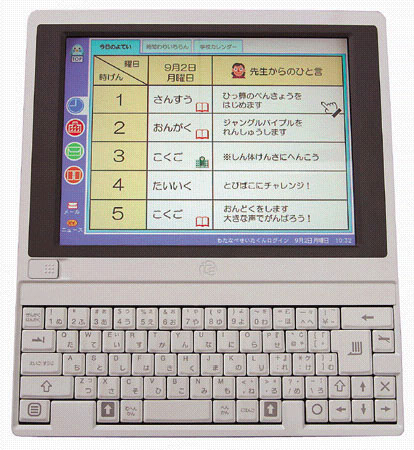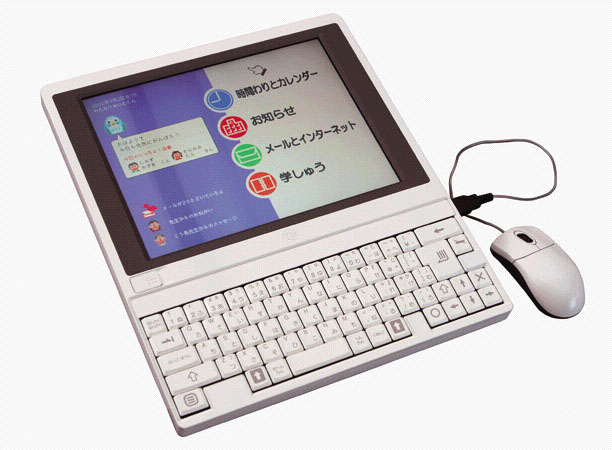


PIN CHANGE Co., Ltd., [1] a new subsidiary in the Matsushita group, announced at the end of October a T-Engine-based educational terminal, which it plans to market to primary and middle schools in Japan from April 2003. The new tablet-style computer, called the "TEA Terminal" (TEA being a acronym for "T-Engine Appliance"), uses portions of the BTRON3-specification operating system marketed by Personal Media Corporation, the firm that is also responsible for marketing and supporting the T-Engine development kit that PIN CHANGE used. Since the TEA Terminal is a prototype, a complete specification is still unavailable (the details announced to date are given in the table below), and the retail price has yet to be decided. However, the Internet-compatible device is expected to be marketed at under 60,000 yen. In addition, the firm is also planning a version for office/home use. According to Vol. 78 of TRONWARE, the company expects sales of up to 1 million units in fiscal year 2004.
Since Matsushita Electric Industrial Co., Ltd., developed and marketed through a subsidiary the first commercially available BTRON-specification computer, the PanaCAL ET intended for use in Japanese middle schools, it might be interesting to compare the TEA Terminal with it. It should be kept in mind, however, that the PanaCAL ET was intended to be sold in sets of 20 to 30 machines along with a more capable teacher's computer, so the price cannot be directly compared. The first BTRON-specification computer for the general public in Japan was the "1B/note," a 16 Mhz i80386SX-based notebook computer that initially marketed for 398,000 yen (standard price: 485,000 yen) in the fall of 1991. That price is almost seven times the projected price of the TEA Terminal. Another big difference between the two standards is that the PanaCAL was to be used inside a wired LAN, while the TEA Terminal is compatible wireless LAN standards and PHS, which means it can also be used while roaming or at home.
| TEA Terminal (2003) | PanaCAL ET (1990 FDD Type) | |
| Standard | Based on the T-Engine standard | ET Master (based on the BTRON/286 standard) |
|
|
||
| Dimensions & weight | 270 mm x 250 mm, approximately 1 kilogram | 330 mm x 358 mm x 125 mm (main unit W x D x H), 8.2 kilograms (FDD type) |
| CPU | SH7751R (32-bit, 200 MHz) | i80286 (16-bit, 8 MHz, 0 wait) |
| Main memory | 64 Megabytes SDRAM | 3 Megabytes DRAM (plus 16 Kilobytes ROM., 256 Kilobytes graphic RAM, and 8 Kilobytes text RAM) |
| Non-volatile memory | 8 Megabytes Flash ROM | 1 Megabyte FDD x 2 (HDD type had a 20/40 Megabyte HDD + 2 FDDs) |
| Display | 10.4 inch/7 inch (800 x 600 dot; 256 or more colors) | 15 inch CRT (640 x 400 dot; any 16 of 4,096 colors for graphics) |
| Interfaces | USB1.1 x 2 ports; serial port x 1 port | LAN card, educational use card, superimpose card, monitor, keyboard/mouse |
| Slots | CF card x 1; SD x 1; eTRON | Expansion slot x 4 (1 used for memory) |
| Network | IEEE802.11b; PHS | IEEE802.3 (M Link) 10Mbps |
| Keyboard | User custom arrangement; about 18 mm pitch | TRON keyboard, or standard Japanese-language keyboard |
| Sound | Headset terminal x 1, headphone terminal x 1 | Headset terminal x 1 |
|
|
||
| Kernel | T-Kernel | ITRON |
| Window system | Based on BTRON | Based on BTRON |
| Multimedia | BTRON-based Web browser | Laser disk drive, VTR |

Many people have remarked about how much the TEA Terminal resembles the original Dynabook concept machine of Alan Kay [2]. However, it is best to keep in mind that Alan Kay's computer was supposed to be a personal computer that could be programmed even by children. For that purpose he developed the Smalltalk object-oriented programming language, which in its latest incarnation is called "Squeak." Accordingly, for the TEA Terminal to be transformed into a true Dynabook, it would have to be loaded with the Squeak programming language, or at least something similar to it.
____________________
[1] PIN CHANGE is actually an acronym that stands for "Panasonic Innovative Navigator, Culture Home Appliance Nature Globe Education." Their English-language Web page is here.
[2] Alan Kay's discussed the Dynabook and his ideas about educational computing on October 15, 1998, at EDUCOM '98, where he gave a presentation titled, "The Computer "Revolution Hasn't Happened Yet!" You can see the hour long presentation via a 56 Kbps feed by clicking the following URL.
http://www.educause.edu/conference/e98/kay.ram
During his presentation, you can see a drawing of the original Dynabook in the upper right-hand portion of the screen just after he mentions impact tests that he did to ensure that the Dynabook could survive children hitting baseballs with it.
For those of you who do not have a good connection to download the video or cannot follow his spoken English, many of the same ideas are in the written interview at the following link.
http://www.honco.net/os/kay.html
Personal Media Corporation announced on November 19 that it would begin market two new T-Engine-specification development platforms and one new µT-Engine-specification development from the end of November. These are: (1) the T-Engine/VR5500 Development Kit, based on NEC Corp.'s VR5500 processor with a peak speed of 800 MIPS (standard price: 198,000 yen, tax not included); (2) the µT-Engine/VR4131 Development Kit based on NEC's VR4131 processor (standard price: 158,000 yen, tax not included); and (3) T-Engine/ARM720-S1C based on Seiko Epson Corp.'s S1C38000 processor based on ARM Ltd.'s 720T core (standard price: 198,000 yen, tax not included).
| T-Engine/VR5500 | µT-Engine/VR4131 | T-Engine/ARM720-S1C | |
| CPU | NEC VR5500 (MIPS IV, 400 MHz, 800 MIPS) | NEC VR4131 (MIPS II, 200 MHz, 340 MIPS) | EPSON SIC38000 (ARM 720T, 72 MHz) |
| Flash memory | 16 Megabytes | 16 Megabytes | 8 Megabytes |
| SDRAM | 128 Megabytes | 32 Megabytes | 32 Megabytes |
| Input I/F | USB (Host), PCMCIA card, serial, eTRON chip, headphone output, microphone input, expansion bus I/F (PCI compatible), JTAG-I/F | Compact Flash (CF) card, serial, eTRON chip, MMC card, expansion bus I/F (PCI compatible), JTAG-I/F | USB (Host), PCMCIA card, serial, eTRON chip, headphone output, microphone input, expansion bus I/F |
| Other functions | RTC, analog RGB output (800 x 600 dot) | RTC | RTC |
| Power source | AC adapter | AC adapter | AC adapter |
| External dimensions | CPU board 120 mm x 75 mm (with no protuberances) | CPU board: 60 mm x 85 mm (with no protuberances) | CPU board 120 mm x 75 mm (with no protuberances) |
| LCD board | TFT color 240 x 320 dot touch panel, key SW x 3, Ir input | TFT color 240 x 320 dot, touch panel, key SW x 3 | |
| Expansion board(s) | IDE interface, up to 1,024 x 768-dot VGA output, LAN function | IDE interface, up to 1,024 x 768-dot VGA output, LAN function | LAN board, debug board, battery board |
For sale inquiries, please contact Personal Media's Sales Department.
E-mail: sales@personal-media.co.jp